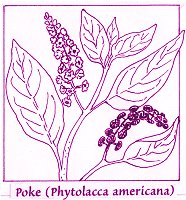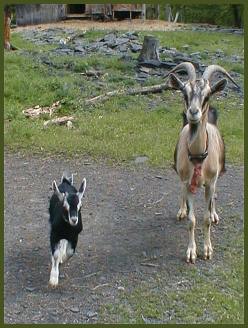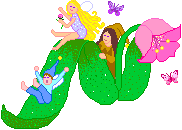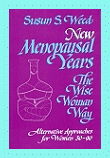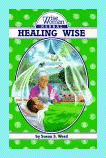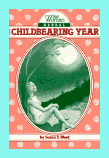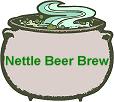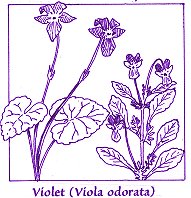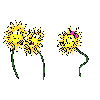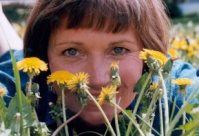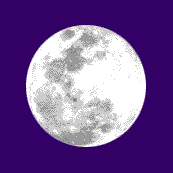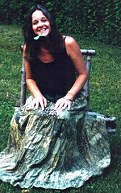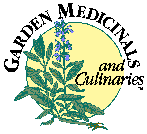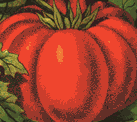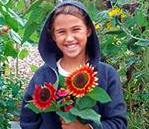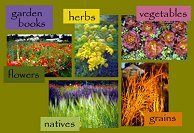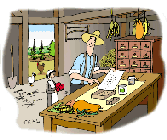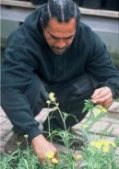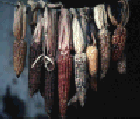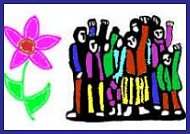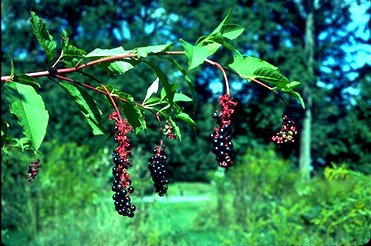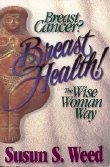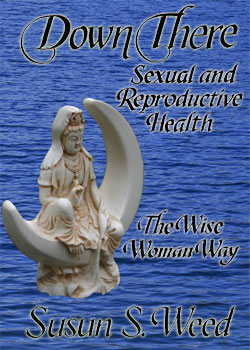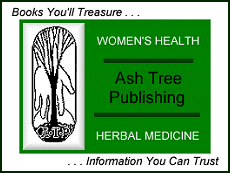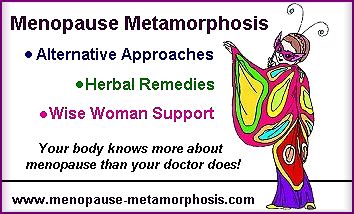Your garden. What fun -- and frustration -- await you there! The best
mentor you can choose, as far as I'm concerned is Nature herself. Nature
likes life everywhere. Have an open field and plants magically appear!
This is the way plants grow when left to themselves. We don't have to
struggle so much.
It is wisest to let Nature have Her way. Nature has her own agenda,
and your life as a gardener will be easier if you bow to Her desires.
Better to dance with the fairies than struggle with eliminating "weeds".
What herbs already grow around you that you can use as teas and seasonings?
Most areas are rich in such plants, both native and introduced. Many
of them will be happy to grace your garden with very little effort on
your part. Some will appear, others may want to be transplanted. Still
others are simply there, waiting for you to notice.
For instance, pine trees. Pine needle vinegar is an exquisite treat
that is easy to make. I call it homemade "balsamic" vinegar.
Fill a jar with pine needles. (I prefer white pine, and pinyon pine
is even better, but the needles of any pine are fine.) Cover needles
completely with apple cider vinegar, filling the jar to the top and
capping with a plastic lid or a piece of plastic wrap held in place
with a rubber band. This vinegar, like most that I make, is ready to
use in six weeks. Pine vinegar is rich in flavonoids, vitamins, and
minerals. It helps keep the immune system strong, and strengthens the
lungs as well. I love it on salads.
Your home, like mine in the Catskills, offers rose hips and sumac berries
for vitamin-C rich teas; spice bush leaves and berries to suggest the
flavors of bay and allspice; and the roots of sweet clover to use as
a vanilla substitute.
Grab a local field guide and go looking for all the plants that are
native to your area. For example, if you live in the northern states
like Minnesota, a great book is "How Indians Use Wild Plants for
Food, Medicine, and Crafts", written in 1926 by Frances Densmore
who collected information from the Minnesota Chippewa. There are many
similar guides available.
Why use native plants? They are often hardy survivors and naturally
adapted to the area, sometimes requiring less watering and care. Whether
in the wilds or in your garden, Nature is ever-ready to provide you
with all you need with little or no input from you. An abundance of
edible and medicinal plants covers every inch of my garden -- and I
didn't plant any of them. With only a little help from me (I spread
compost several inches deep on my gardens spring and fall, and keep
them fenced against my goats and the marauding deer), my gardens grow:
garlic mustard, chickweed, violets, dandelion, curly dock, nettles,
burdock, wild madder, crone(mug)wort, wild chives, poke, catnip, malva,
wild mint, bergamot, cleavers, motherwort, chicory, raspberry, goldenrod,
creeping jenny, barbara's cress, evening primrose, milk weed.
The next best thing to letting Nature plant your herb garden for you
is to put in perennials and let Nature take care of them. You will find
the best plants for your area at a plant swap at a local church or school.
Nurseries, especially the mail order ones, offer lots of different kinds
of plants, but only a few of them will be both productive and carefree.
The most dependable perennial herbs are echinacea, comfrey, elecampane,
wormwood, and thyme, on the hardiest members of the aromatic mint family.
Cuttings of various mints are easy to come by and easier yet to establish.
Chocolate mint and red bergamot are two of my favorites, but don't be
choosy, accept any and all mint cuttings you are given. Perennial aromatic
mints -- including lemon balm, lavender, rosemary, thyme, sage, oregano.
pennyroyal, and catnip as well as spearmint and peppermint -- form the
"backbone" of most herb gardens. Just grow them in full sun
in poor soil and don't overwater.
Anyone who has a comfrey plant will be glad to give you a "start"
(a piece of the root). And, once put in, comfrey is a friend for life.
Ditto rhubarb, whose root is a formidable herbal medicine.
Magazines offer gardening knowledge in small doses, and at appropriate
times, instead of all at once, and this is usually more helpful than
a book that tries to cover all seasons and all reasons. These are my
current (spring 2002) favorites:
The American
Gardener, a publication of the American Horticultural Society.
Perhaps it is a bit more formal than I am, but it nonetheless has a
down-home charm. Check out www.ahs.org or call 1-800-777-7931. When
you join, you get the magazine plus the right to join in their annual
seed give-away.
The
Garden Gate is very practical and covers a wide range of topics
in excellent detail: from plants to planters to planting your feet so
your back stays strong. Every page counts, as there is no advertising.
You can subscribe at www.gardengatemagazine.com
or call 1-800-341-4769.
The
Gardener is another non-advertising production. It is unique
in not using photographs. It is illustrated throughout in a variety
of stunning styles. They offered me a credit worth $20 for plants or
seeds with my subscription. Go to www.thegardenermagazine.com
or call them at 1-877-257-5268.
Herbals that include cultural instructions are good additions to your
library.
Steven Foster's Herbal Bounty is a classic on "The
Gentle Art of Herb Culture." Unfortunately, it is now out of print,
but you may be able to find one used. (c. 1984, Peregrine Smith Books).
He gives detailed information on the culture, and medicinal uses, of
over 100 popular herbs.
Park's Success with Herbs is also out of print but a
book that I use constantly. Gertrude Foster and Rosemary Louden fill
just under 200 pages with an incredible amount of information on growing
and using (lots of recipes) an amazing variety of herbs.
When you try too hard, it doesn’t work. We learn to work with
the slow interplay of Yin and Yang. We learn to be in harmony with nature's
laws. Forcing things to fit or going against the grain is an unskillful
way. We learn to be flexible like water. We use our intuition. We hold,
energetically, a magical spot of ground and watch what grows. In Taoism
they call it "Wu Wei". We walk in the "effortless",
we dance with the fairies, moving in joyful flow with the undulating,
magical greenery blowing in the breeze.
Wow! You have a garden! With patience, good weather, and the grace
of the Goddess, you and Nature will create a thing of beauty.
To
learn more check out Healing Wise by Susun Weed (Click
here to read a review)



